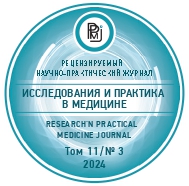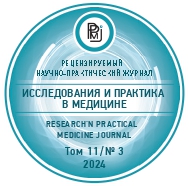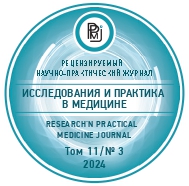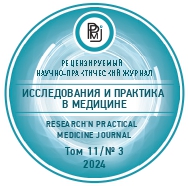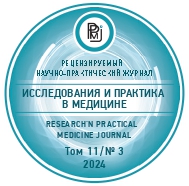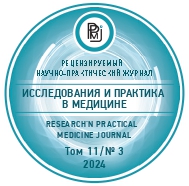Original Articles. Pharmacology, Clinical Pharmacology
Understanding the effects on tumor cells underlies possible practical use of collagen- containing composition (HCCC) for the treatment of radiation therapy related complications.
Purpose of the study. Is to investigate the effects of heterogeneous HCCC on growth, viability, proliferative activity and stem cell pool of cervical cancer in vitro.
Materials and methods. HeLa cells were incubated with commercially available HССC (trademark Sphero®GEL in two versions: Medium and Light) for 24–72 h. We determined the total number of tumor cells, their viability by MTT assay, the total proportion of cells in S + G2 + M phases by flow cytometry, as well as the relative and absolute number of cancer stem cells (CSCs) identified by the ability to remove the fluorescent dye Hoechst 33342 from cells (SP method) and CD133 expression, after incubation with HCCC in two dilutions and in control samples.
Results. When using HCCC–Medium in a dilution of 1/5 (the lowest of the studied dilutions), decrease in the total number of tumor cells by 13 % from the control level was recorded during the entire observation period (p < 0.05). This effect was accompanied by parallel decrease in cell viability and decrease in proliferative activity in the first time after the onset of exposure compared to control (p < 0.05). The tendency towards decreases in the absolute number of CSCs, which were independently detected by SP and CD133 immunophenotyping methods after 72-hour incubation with HCCC–Medium 1/5, was observed. The number of SP and CD133+ cells decreased by 1.3 times compared to control. Similar, but short-term or less pronounced effects were shown for HCCC–Medium in a higher dilution of 1/20 and HCCC–Light in all dilutions in relation to the total number of tumor cells and the size of CSC pool.
Conclusion. The obtained results prove the absence of stimulating effect of HCCC–Medium and HCCC–Light on both the total mass of HeLa tumor cells and the CSC subpopulation in vitro and show the prospects for further preclinical and clinical studies on the use of HCCC in rehabilitation programs for treatment of atrophic and/or radiation vaginitis of varying severity in cancer patients.
Original Articles. Оncology
Purpose of the study. Is to determine the features in the content and activity of some components of the plasminogen activation system in the blood of patients of different ages with leiomyomas (LM) and uterine corpus endometrial cancer (UCEC).
Patients and methods. The study was carried out in patients with LM (n = 35) and UCEC T1a-2N0M0 (n = 56) of reproductive, perimenopausal and postmenopausal ages. Using ELISA methods, the content and activity of urokinase (u-PA), tissue plasminogen activator (t-PA), their inhibitor PAI-1, as well as the content of the soluble form of the u-PA receptor (su-PAR) were determined in the blood of patients. The Student´s test was used for statistical processing.
Results. Regardless of the nature of the uterus tumor, it has been noted a significant increase in the activity and blood level of PAI-1 (up to 8 times, p < 0.01), especially pronounced in patients with UCEC of reproductive age. It was combined with the absence of changes or with a decreasing in blood level of su-PAR by more than 40 % (p < 0.05). We observed a rise of u-PA blood level without changes in one´s activity in patients with LM of perimenopausal age. And in patients with LM and UCEC of postmenopausal age an increase in u-PA blood level as well as elevation of u-PA activity (up to 3.9 times, p < 0.01–0.05) were noted. There was an increase in the calculated t-PA index (activity per unit mass) by 1.4–2.8 times (p < 0.05) in the most patients. The indicators of LM patients were characterized by the minimum value of the ratio “t-PA activity/u-PA activity in the blood” among all studied subgroups of patients. Age-related features of the researched parameters were observed more often in the cases of LM than in the cases of UCEC. The most pronounced differences between LM and UCEC were observed in patients of reproductive and postmenopausal age, characterized by stable hormonal levels.
Conclusion. The participation of the plasminogen activation system in the pathogenesis of tumor lesions of the uterine body has been shown. The system’s “response” to the development of tumors in the uterus has both general characteristics and features that depend on the nature of the tumors and on the age-specific hormonal regulation of the body, which are most pronounced in postmenopausal women. The results obtained can be used in research aimed at clarifying the targets of targeted therapy for LM and UCEC in accordance with the age of patients.
Thyroid hormones (TH) influence the processes of cell proliferation and differentiation, but their role in the processes of carcinogenesis is contradictory.
The purpose of the study. To study the effect of induced hyperthyroidism in mice of both sexes with intertwined Lewis carcinoma (LLC) on the activity of the hypothalamic-pituitary-thyroid axis (GGT).
Materials and methods. The experimental model was mixed-sex mice of the C57BL/6 line with subcutaneously transplanted LLC on the background of induced hyperthyroidism (main group). Two control groups were used: control group I – mice with sodium liothyronine- induced hyperthyroidism and control group II – mice with subcutaneously transplanted LLC. On the 25th day after tumor transplantation, the level of thyrotropin- releasing hormone (TRH), thyroid- stimulating hormone (TSH), triiodothyronine (T3), total and free thyroxine (T4, FT4) was determined in the homogenates of GGT organs and in blood serum.
Results. In female mice, hyperthyroidism caused an increase in the level of TRH in the hypothalamus and a decrease in TSH in the pituitary gland; in males, a decrease in TRH only in the hypothalamus. In control group II, euthyroid disorder syndrome developed: In mice of both sexes, serum levels of T4 and FT4 were found to decrease against the background of unchanged T3 levels and an increase in TSH content only in females. In the females of the main group, an increase in the level of TSH in the thyroid gland caused a decrease in T3 content in 73 % of animals against the background of normal T4 and elevated FT4 levels, in 27 % of females the T3 level increased. In males, in 73 % of the observations, the T3 level was increased against the background of high T4 and FT4 values and unchanged TSH levels. In the skin and LLC samples of the mice of the main group, an increase in T3 levels was noted.
Conclusion. The growth of LLC against the background of hyperthyroidism is a process with multifactorial effects. High levels of T3 in blood serum and skin stimulated the proliferation of tumor cells, which led to the formation of subcutaneous tumors of a larger volume in the mice of the main group. Sex differences in the GGT response indicate different mechanisms that implement pathological processes.
Purpose of the study. Preclinical study in experiment of antitumor efficacy of a new substance synthesized on the basis of pyrimidin-4-one derivative.
Materials and methods. The sodium salt of 4-{2-[2-[2-(4-hydroxy-3-methoxyphenyl)-vinyl]-6-ethyl-4-oxo-5-phenyl-4H-pyrimidin-1-yl}-benzsulfamide, a new inhibitor of the internal domain of the epidermal growth factor receptor (EGFR), was used in this study. All C57BL6 mice of both sexes were subcutaneously transplanted with B16/F10 melanoma. Twenty-four hours after tumor transplantation, mice in the main group (n = 18) were injected with a new EGFR inhibitor intramuscularly at a dose of 0.375 mg per mouse (15,0 mg/kg animal masses), while mice in the control group (n = 18) were injected with saline for injection. In both groups administration was carried out before natural death of animals according to the scheme: administration daily for 5 days, followed by 2 days of break. The dynamics of animal weight, dynamics of tumor node volume were evaluated, the tumor growth inhibition index (TGII) was calculated.
Results. Tumor visualization time and animal weight did not statistically significantly differ between the groups during the whole study. In the main group there was a longer lifespan by 1.5 times on average (p ≤ 0.05), and smaller average tumor volume (by 19.2 times on 14 days in males, by 4.3 times in females, by 4.3 times on 28 days in males, by 2.5 times in females, p ≤ 0.05) than in the control group. At the same time, in the main group the tumor volume was smaller in males by 2.7 and 1.8 times (p ≤ 0.05), respectively on days 25 and 28 than in females. TGII in mice of both sexes was maximal on the 14th day with subsequent decrease by 40.3 % in females and only by 18.6 % in males, and during the whole experiment TGII in males was higher.
Conclusion. The results showed inhibition of melanoma growth and increased lifespan of mice of both sexes (more pronounced in males) in the group with administration of a new EGFR inhibitor. This indicates the promising potential of this compound and the need to continue its preclinical study in other tumor models.
Original Articles. Diagnostic radiology
Purpose of the study. To study the CT semiotics of intrahepatic cholangiocarcinoma (ICC) to determine the prognostic markers of recurrence. To analyze the association between CT characteristics of ICC and mutations in IDH1/2, MET, KRAS, BRAF, ERBB2, EGFR, FGFR genes.
Materials and methods. We analyzed databases and diagnostic images of Vishnevsky National Medical Research Center of Surgery and Loginov Moscow Clinical Research Center for the period from April 2016 to January 2022 using the key queries «intrahepatic cholangiocarcinoma», «liver», «hepatocellular carcinoma», «metastases», «radio genomics». 142 patients with liver neoplasms were identified, including 90 cases of ICC, 31 cases of hepatocellular carcinoma and 21 cases of metastatic liver lesions, all morphologically verified (histologic and immunohistochemical analysis of biopsy material).
Results. Associations between CT features and mutations of MET and IDH1/2 genes were determined. According to the results of statistical analysis all four CT-signs, such as bile duct dilatation, capsule retraction, presence of dropout foci and tissue volume changes, are correlated with the probability of recurrence (death) in patients with ICC.
Conclusion. In a retrospective study, our results emphasize the potential prognostic significance of CT signs of ICC. We identified CT signs that allow differential diagnosis of ICC with hepatocellular carcinoma and colorectal cancer metastases. We also identified associations between CT signs of ICC and mutations of IDH1/2 and MET genes, which may allow us to non-invasively obtain data on clinically significant molecular markers of tumors to apply a personalized approach to patient treatment.
Original Articles. Urology
Purpose of the study was to compare of the average long-term results of classical prostate enucleation using the Millin method and enucleation performed using a holmium laser (HoLEP).
Patients and methods. This study, conducted on the basis of the Endocrinology Research Center of the Ministry of Health of the Russian Federation, included 100 patients operated on for obstruction of the prostatic part of the urethra over the period 2020–2023. The main indication for surgery was benign prostatic hyperplasia. The selection criterion for patients was a prostate volume of more than 80 cm3. The patients were divided into 2 groups depending on the intervention performed: in the 1st group Millin surgery was performed (n = 50), in group 2n laser enucleation of the prostate was done (n = 50). The data obtained during the operation in the early postoperative period, as well as the results of postoperative follow-up of patients were analyzed.
Results. In the mid-term period, 4–6 months after surgery, patients from both groups were observed to improve their condition and reduce complaints of dysuric phenomena. The results were obtained illustrating a shorter inpatient stay for patients who underwent HoLEP (4.3 ± 0.6 days versus 10.0 ± 2.4 during Millin surgery), which is correspondingly associated with a faster recovery after this intervention compared with the classic one. A statistically significant (p-value < 0.05) problem of patients from the HoLEP group was urethral stricture, which occurred in 6 % of the subjects from this group and did not occur in the Millin surgery group. In fact, scarring of the bladder neck was more commonly obserbed (10 % vs. 8 %) in the Millin surgery group. However, these complications were not more than 10 %. As a result of the study, there was no statistically significant effect of using HoLEP on erectile dysfunction in patients, which suggests the potential of this technique for a lower incidence of worsening erectile dysfunction compared with open intervention.
Conclusions. HoLEP is a safe method of prostate enucleation, applicable for its large volume, in particular, up to 80 cm3. This procedure is an alternative to classical open surgery, and can be recommended for patients with polymorbidity to reduce the risk of perioperative complications and reduce rehabilitation time. Millin surgery is also a reliable treatment method with high sensitivity to the detection of cellular atypia and a large volume of cytoreduction. The decision on the surgical procedure used must be made individually for each patient.
Review
The development of omics technologies and sequencing has significantly expanded the understanding of the role of microorganisms that inhabit various human organs and collectively make up its microbiota in the development of cancer. The extensive literature of recent years devoted to various aspects of the participation of the microbiota in carcinogenesis substantiates the relevance of analyzing the impact of its features on the processes of carcinogenesis in various human organs.
Purpose of the study. Analysis of literature data on the key issues of the relationship between the human microbiome and the risk of cancer and explore possible prospects for its use in the diagnosis, therapy and prevention of cancer.
Materials and methods. A literature search was carried out in the databases NCBI MedLine (PubMed), Scopus, Web of Science, based on an extended list of keywords that included all the localizations of malignant neoplasms (MNs) considered in the review. Original studies, meta-analyses, randomized controlled trials, and reviews published in recent years were used.
Results. Recent studies using omics technologies have shown significant differences in the composition of microbial communities of healthy and tumor tissues and have made it possible to characterize the potential tumor microbiota in some types of cancer. The microbiota present in the various organs of the human body forms a network through which it interacts via migration or by forming metabolic axes between organs. Dysbiosis plays an important role in carcinogenesis, and its presence in one organ can negatively affect the condition of other distant organs and contribute to the development of pathological conditions in them.
Conclusion. Numerous studies conducted over the past decade have revealed a complex relationship between microorganisms, tumors, and the host, reflecting the diverse effects of the microbiota on various organ- specific types of MNs. Gastrointestinal tract tumors, as well as sites outside it with significant bacterial associations, have been identified for a better understanding of the multifaceted mechanisms by which the microbiota influences cancer. The data obtained so far complement the emerging possibilities of using the microbiota in clinical practice, which represents a new approach to the prevention and treatment of malignant neoplasms.
Purpose of the study. Analysis of the molecular and biological features of synovial sarcoma (SS), as well as its tissue microenvironment according to modern research.
Materials and methods. The analysis of literature sources was carried out mainly in the databases «Istina» and «PubMed», publication date limitations were set up from 2019 to 2023. The following keywords for the search were used: «synovial sarcoma», «chromosomal aberrations», «carcinogenesis».
Results. Understanding the molecular mechanisms and signaling pathways in the development of SS may lead to the development of more effective treatment strategies. The importance of further research in this area cannot be overestimated, as it can provide new data to create innovative approaches aimed at improving the prognosis and quality of patients’ lives. Chromosomal aberrations, such as translocations and deletions, can lead to the activation of oncogenes or inactivation of tumor suppressor genes, which, in turn, contributes to the malignant transformation of cells. Epigenetic changes such as DNA methylation and histone modifications also play an important role in the regulation of genes related to the growth and survival of tumor cells. Disorders in these processes can contribute to tumor progression by altering the expression of key genes involved in the cell cycle, apoptosis, and angiogenesis. Additionally, part of the review is devoted to the interaction of atypical cells against the background of chromosomal aberrations and epigenetic changes with the SS microenvironment. These factors may have a certain effect on the growth and progression of synovial sarcoma. In addition, the review discusses various aspects of the diagnosis of SS using modern molecular genetic methods. Examples of successful use of targeted therapy and immunotherapy are given, which open up new prospects in the treatment of this disease.
Conclusion. The importance of molecular biological and molecular genetic analysis of SS for the possibility of an interdisciplinary approach in the study and treatment of this aggressive malignant tumor has been revealed.
Clinical Case Reports
The issue on the differential diagnosis of formations of purulent-inflammatory etiology and the choice of treatment method taking into account the visual picture does not lose its relevance. Ultrasound (US) is not less crucial than computed tomography (CT) for the primary diagnosis of spleen abscesses. This article presents clinical observations of patients with suspected spleen abscesses admitted to the emergency room of the Novosibirsk City Clinical Hospital No. 1 with emergency indications for 2017–2022. All patients underwent ultrasound with Philips Affiniti 70G, Mindray M9, and General Electric Logiq P6 devices. While performing ultrasound in In-mode, attention was paid to the main signs: localization (in the parenchyma, subcapsular), quantity, contours (wall thickness), the nature of the abscess contents, dimensions (volume calculated according to the formula for irregularly shaped formations, A × B × C × 0.52), the presence or absence of effusion in pockets the spleen. The formations were classified by volume into small (up to 50 ml), medium (50–100 ml) and large (more than 100 ml). The main ultrasound signs in the seroscale mode have been determined. The presented clinical observations illustrate the possibilities of ultrasound for deciding on the method of treatment: for primary diagnosis (including emergency), it was possible to determine the presence of formations of purulent- inflammatory etiology, to determine the localization, the main signs in which minimally invasive treatment was effective (formed abscess of "medium" volume). Surgical abdominal treatment was preferable in the presence of multiple abscesses (without a formed capsule) of small size.



